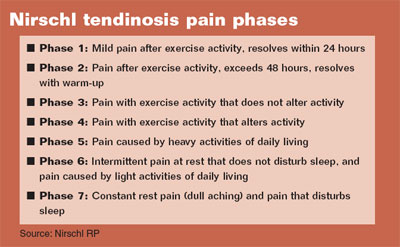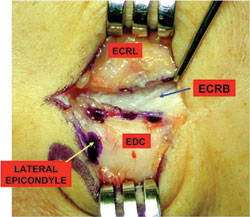Most cases of lateral tennis elbow respond well to conservative treatment
Robert P. Nirschl, MD, explains the underlying pathology and best treatments for this injury.
Click Here to Manage Email Alerts
Robert P. Nirschl, MD, is a long-time friend who has devoted many years to studying and publishing his research on the treatment of lateral tennis elbow. I turned to him for this month’s
4 Questions interview dealing what can be a frustrating entity to treat in active patients who want a quick cure.
Douglas W. Jackson, MD
Chief Medical Editor
Douglas W. Jackson, MD: Exactly what is your definition of lateral tennis elbow?

Robert P. Nirschl, MD: It is best to start with tendon histopathology (ie, angio-fibroblastic tendinosis). In our 1979 Journal of Bone and Joint Surgery report, we described lateral tennis elbow as angio-fibroblastic hyperplasia (A-F hyperplasia) of the extensor carpi radialis brevis (ECRB) and, on occasion, a small area of the antero-medial border of extensor digitorum communis (EDC). I combined the descriptive term (angio-fibroblastic) with Paddu’s term of tendinosis, thus the current terminology of angio-fibroblastic tendinosis.
Over the years, my identification of the primary location for lateral tennis elbow has not changed. Occasionally, additional companion issues such as lateral epicondylar exostosis, intra-articular synovial plica and posterior interosseous nerve neuropraxia may occur. Careful clinical and imaging evaluations should be used to rule out these additional issues, which occur in fewer than 5% of cases.
Jackson: What is your nonoperative approach?
|
|
Nirschl: The large majority of cases respond to appropriate nonoperative care. The curative goal biologically is to revitalize the semi-dead A-F tendinosis tissue with neovascularization; functional fibroblastic infiltration, which includes collagen production; and the broader concepts of restoration of strength, endurance and flexibility. Often, treatment protocols of anti-inflammatory medications (including cortisone injections) and rest might buy temporary comfort but do not directly promote cure. Absolute rest such as casting or Botox paralysis invites atrophy and diminished vascularization.
Stimulation-to-normal-tendon approach with growth factors via local injection of autologous blood is now being tried. Some are trying shockwave therapy, prolotherapy and dry needling in hopes of repairing the tendon scar (not regeneration) by stimulating an inflammatory cascade. A-F tendinosis alteration to healthy tissue by these approaches is inconclusive, however, and I have operated on failures of all of these techniques.
My current nonoperative approach includes short-term pain control (ie, approximately 1 week) with relative rest, activity modification, counter-force functional bracing and NSAIDS vs. occasional cortisone injection or iontophoresis for extreme pain. I use curative concepts to invite neovascularization, collagen production as well as strength endurance and flexibility including, rehabilitative exercise and high-voltage stimulation.
|
Image: Nirschl RP |
Jackson: What are your thoughts concerning the use of an arthroscopic approach?
Nirschl: In using arthroscopic techniques, there is a high likelihood of leaving pain-producing pathological tissue behind. The problem is that we demonstrated inadequate arthroscopic identification and resection of tendinosis tissue in our own cadaver studies. This was also demonstrated in the 2006 report of Cummings and colleagues in the American Journal of Sports Medicine.
Besides the marketing aspect, there are essentially two advantages of arthroscopic surgery cited by its proponents. These include a more rapid functional return and the opportunity to treat intra-articular problems. The rapid rehab issue may be true if compared to poor open techniques, which utilize excessive tissue dissection. There is no postoperative advantage, however, when compared to our mini-open technique.
There is a place for elbow arthroscopy for specific primary intra-articular abnormalities such as loose bodies, etc., but in my view, the arthroscopic approach for extra-articular elbow tendinosis is not indicated as it increases costs and risks neurovascular and intra-articular harm.
Jackson: What is your preferred surgical approach?
Nirschl: As for the surgical indications, failure of an appropriate rehabilitation exercise program is paramount. The Nirschl pain phases 5, 6 or 7 and a self-reported unacceptable quality of life by the patient are also key indications (see table).
The surgical concept is not to release the extensor attachments, which are almost always normal. The goal of my technique is to only resect the tissue that is pathological (ie, the pain-producing A-F tendinosis tissue in the ECRB). I would like to be crystal-clear about this, as many of the so-called Nirschl procedures done worldwide are poorly done.
In approximately 50% of cases, the resection also includes the anteromedial edge of the EDC. I also drill one small hole through cortical bone in the triangular recess area of the lateral condyle (not the epicondyle) to enhance vascular infiltration and possibly the growth factors.

Accurate identification of the tendinosis areas (ie, the gray friable edematous tissue) is critical and can be easily done without optical assistance if the exposure is correct. My standard mini-incision is only 3 cm, but it must be accurately placed for correct access and identification of the ECRB.
It might also be noted that with proper resection of the ECRB tendinosis, it is unnecessary to reattach the remaining normal distal ECRB at the level of the joint line, as the ECRB does not retract. This is because the ECRB has a firm attachment to the EDC at the level of the radial head and annular ligament.
If the surgery is done well, you can expect a 97% improvement and a 93% return to the same sports level. Even with salvage redo surgery, you can expect 83% improvement if the principles of clear identification and excision of tendinosis tissue are followed.
For more information:References:
- Robert P. Nirschl, MD, can be reached at 1715 North George Mason Drive, #504, Arlington, VA 22205; 703-525-2200; e-mail: nirschlorthopaedics@comcast.net.
- Cummins C: Lateral epicondylitis: in vivo assessment of arthroscopic debridement and correlation with patient outcomes. Am J Sports Med. 2006; 34(9): 1486-1490.
- Dunn J, Kim J, Davis L, Nirschl R: Ten- to 14 year follow-up of the Nirschl surgical technique for lateral epicondylitis, Am J Sports Med. 2008; 36 (2): 261-266.
- Kraushaar B, Nirschl R. Tendinosis of the elbow. Clinical features and findings of histological, Immunochemical, and electron microscopy studies. J Bone Joint Surg (Am). 1999; 81-A (2): 259-278.
- Kraushaar B, Nirschl R, Cox W. A modified lateral approach for release of post traumatic elbow flexion contracture. J Shoulder Elbow Surg. 1999; 8(5): 476-480.
- Nirschl R, Pettrone F. Tennis elbow. The surgical treatment of epicondylitis. J Bone Joint Surg (Am). 1979; 61: 832-839.
- Nirschl R, Sobel J. Arm care. A complete guide to the prevention and treatment of tennis elbow. 1996; Arlington Va.: Medical Sports Publishing.
- Organ S, Nirschl R, Kraushaar B, Guide E: Salvage surgery for lateral tennis elbow. Am J Sports Med. 1997; 25:746-750.


